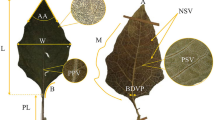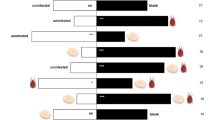Abstract
Pieris napi oleracea, an indigenous butterfly in North America, lays eggs on Alliaria petiolata, an invasive weed that was introduced from Europe. However, larval development on plants from different sources varies considerably. A. petiolata is a compulsive biennial, and its foliage is rich in apigenin flavonoids. We compared the chemistry of different vegetative forms from different populations in the vicinity of Ithaca, NY throughout the year. Significant differences occurred in the number of apigenin derivatives in different populations and vegetative forms, and seasonal variations in the amounts of these compounds were found. We have previously isolated two major compounds, alliarinoside [(2Z)-4-(β-D-glucopyranosyloxy)-2-butenenitrile] (1) and isovitexin-6-O″β-D-glucoside (3), which negatively affect development of P. napi oleracea larvae. Comparative analyses of these compounds in two populations throughout the year showed that their concentrations reached maxima twice annually. Foliage is almost devoid of flavonoids in June-July. Thus, variation in the chemistry of the plant may account for observed variation in development rates and survival of the larvae. Several apigenin compounds were isolated and identified by spectral studies.
Similar content being viewed by others
REFERENCES
BOHM, B. A., BANEK, H. M., and MAZE, J. R. 1984. Flavonoid variation in North American Menziesia (Ericaceae). Syst. Bot. 9:324–345.
CHAVES, N., ESCUDERO, J. C., and GUTIERREZ-MERINO, C. 1993. Seasonal variation of exudate of Cistus ladanifer. J. Chem. Ecol. 19:2577–2591.
CHAVES, N., ESCUDERO, J. C., and GUTIERREZ-MERINO, C. 1997. Role of ecological variables in the seasonal variation of flavonoid content of Cistus ladanifer exudate. J. Chem. Ecol. 23:579–603.
CHEW, F. S., GOODWILLIE, C., and MILBURN, N. S. 1996. Larval responses of two Pieris butterflies to naturalized Cruciferae. Am. Zoologist 29:167A.
CHEW, F. S. 1980. Food plant preferences of Pieris Caterpillars (Lepidoptera). Oecologia (Berl) 46:347–353.
CHEW, F. S. 1981. Coexistence and local extinction in two pierid butterflies. Am. Naturalist 118:655–672.
CHULIA, A. J., and MARIOTTEE, A. M. 1985. New C-glucosylflavones in Gentiana pedicellata. J. Nat. Prod. 48:480–483.
COOPER-DRIVER, G., FINCH, S., SWAIN, T., and BERNAYS, E. 1977. Seasonal variation in secondary plant compounds in relation to the palatability of Pteridium aquilinum. Biochem. Syst. Ecol. 5:177–183.
COURANT, A. V., HOLBROOK, A. E., VAN DER REIJDEN, E. D., and CHEW, F. S. 1994. Native pierine butterfly (Pieridae) adapting to naturalized crucifer? J. Lep. Soc. 48:168–170.
CUADRA, P., HARBORNE, J. B., and WATERMAN, P. G. 1997. Increases in surface flavonols and photosynthetic pigments in Gnaphalium luteo-album in response to UV-B radiation. Phytochemistry 45:1377–1383.
HARIBAL, M., and RENWICK, J. A. A. 1998. Isovitexin 6"-O-?-D-glucopyranoside: A feeding deterrent to Pieris napi oleracea from Alliaria petiolata. Phytochemistry 47:1237–1240.
HARIBAL, M., RENWICK, J. A. A., and ATTYGALLE, A. 1999. A new sinapoyl derivative of isovitexin 6"-O-?-D-glucopyranoside from Alliaria petiolata. J. Nat. Prod. 62:179–180.
HARIBAL, M.,YANG, Z., ATTYGALLE, A. B., RENWICK, J.A. A., and MEINWALD, J. 2001.ACyanoallyl Glucoside from Alliaria petiolata, as a Feeding Deterrent for larvae of Pieris napi oleracea. J. Nat. Prod. (in press).
HUANG, X. P., and RENWICK, J. A. A. 1993. Differential selection of host plants by two Pieris species: The role of oviposition stimulants and deterrents. Entomol. Exp. Appl. 68:59–69.
MALHOTRA, B., ONYILAGHA, J. C., BOHM, B. A., TOWERS, G. H. N., JAMES, D., HARBORNE, J. B., and FRENCH, C. J. 1996. Inhibition of tomato ringspot virus by flavonoids. Phytochemistry 43:1271–1276.
NIELSEN, J. K., DALGAARD, L., LARSEN, L. M., and SORENSEN, H. 1979. Host plant selection of the horseradish flea beetle Phyllotreta armoraciae (Coleoptera: Chrysomelidae): Feeding responses to glucosinolates from several crucifers. Entomol. Exp. Appl. 25:227–239.
NUZZO, V. 1993. Distribution and spread of the invasive biennial Alliaria petiolata (garlic mustard) in North America, pp.137–145, in W. N. MCKNIGHT (ed.). Biological Pollution: the Control and Impact of Invasive Exotic Species. Indiana Acad. Sci., Indianapolis.
PARIS, R. R., and DELAVEAU, P. 1962. Isolement d'un nouvel hétéroside flavonique, La alliaroside des feuilles de l'Alliaria officinalis Andrz., (Cruciféres). C. R. Acad Sci. 254:928–929.
RENWICK, J. A. A., ZHANG, W., HARIBAL, M., ATTYGALLE, A. B., and LOPEZ, K. D. 2001. Dual chemical barriers protect a plant against different larval stages of an insect. J. Chem. Ecol. 27:1593–1601.
SZENTESI Á. 1991. Controversial component of plant apparency in Alliaria petiolata Cavara & Grande (Cruciferae), pp. 237–244, in Á. Szentesi, and T. Jeremy (eds.). Symposia Biologica Hungarica: Insects-Plants' 89 Academia Kiado, Budapest.
Author information
Authors and Affiliations
Rights and permissions
About this article
Cite this article
Haribal, M., Renwick, J.A.A. Seasonal and Population Variation in Flavonoid and Alliarinoside Content of Alliaria petiolata. J Chem Ecol 27, 1585–1594 (2001). https://doi.org/10.1023/A:1010406224265
Issue Date:
DOI: https://doi.org/10.1023/A:1010406224265




